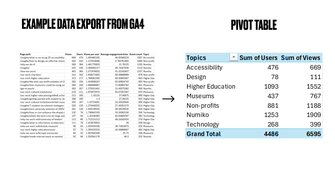How to run an effective website content audit
Running a content audit can help you simplify your digital estate and get better results by better targeting your content efforts.
A huge amount of time and budget is invested in creating high-quality content to attract and engage visitors. But as your website evolves, some of that content can become outdated, redundant, or simply ineffective. Running regular content audits helps ensure your site continues to meet its goals by identifying weak spots and opportunities for improvement. It’s also an essential first step for managing an effective content migration, should you be moving to a new content management system.
In this article, we’ll cover the fundamentals of executing a successful website content audit. We’ll cover why auditing content matters, which tools to use, how to analyse the results, and how to put them into practice. This will let you run content audits more effectively and ultimately get better results from your website.
WHY AUDIT YOUR WEBSITE CONTENT?
Meeting your KPIs starts with measuring them. An audit is a way of measuring the effectiveness of your website. Done right, the audit will provide data-driven insights that can shape a smarter, more effective content strategy. It will also identify pages that fail to drive traffic or engagement, and can therefore be removed.
Using this data, you can refocus your efforts on content that is more effective at achieving your objectives. Audits also uncover technical issues like broken links or metadata errors, which can improve your site’s SEO when fixed. In addition, the process reveals content gaps you can fill and the most effective formats and topics to leverage based on top performing pages.
By regularly reviewing content performance, you can ensure your website continually evolves to stay relevant, useful, and aligned with overarching goals.
KEY TOOLS FOR EFFECTIVE CONTENT AUDITS
The right tools are critical for running quantitative and qualitative content assessments. We consistently find these three to be the most useful:
- Google Analytics 4 – This lets you analyse visitor traffic and engagement data for each page. It is helpful for identifying low-traffic or bounce-prone pages.
- SEMrush – SEMrush’s site audit tool provides a technical SEO audit, revealing issues like errors, outdated metadata, or ‘thin’ content.
- Google Search Console – This lets you see what search terms users are driving traffic to your site, and how pages are performing in organic search results. It is helpful in ascertaining which content is effective at driving organic traffic, as well as which content is performing poorly. Pages with large numbers of search impressions but few clicks are prime targets for improvement.
These tools give you quantitative data on the performance of your website. The data they generate should be combined with human judgement via stakeholder discussions and manual reviews. This delivers a well-rounded perspective on what content to prune, improve, develop, or leverage further.
RUNNING A CONTENT AUDIT
Before you get stuck into the task of running your content audit, it’s best if you first define your content objectives. Clarify who your users are, what they need, and what you want your content to impart. Goals might include; improving conversions, growing organic traffic, demonstrating thought leadership, or a combination of the above.
With your objectives set, you’re ready to get started. Running an effective content audit involves three distinct tasks: quantitative audit, qualitative audit, and stakeholder consultation.
You can run a quantitative audit using the tools listed in the previous section. The hard data this provides uncovers what you need to change so you can focus your efforts on the most important areas.
The qualitative site audit is done manually to provide richer insights on elements like tone of voice, readability, and user experience. It can help provide insights on how your content could be improved.
Involving stakeholders is also important, as this lets you build up a picture of why the site’s content is the way it is, and lets you understand how the existing content strategy shaped the content that already exists. This insight is important in informing your future agenda for content production.
IDENTIFYING UNDERPERFORMING CONTENT
A key part of the quantitative content audit is identifying underperforming content. You can do this using the tools listed in the earlier tools section.
Export data from Google Analytics and Search Console on the performance of every page on your website. Sort the data exports by views/clicks to identify the underperforming content. These are pages that are getting very little traffic in the last 6 months. ‘Very little’ is a relative term, of course. It depends on how much traffic your site overall gets. Our rule of thumb is that any page that receives less than 0.1% of your total website traffic is likely underperforming and should be considered for deletion or redevelopment. This is just a useful heuristic though. Just because a page gets very low traffic doesn’t always mean the page should be deleted or rewritten. For example, you might need to have certain policies on your website for compliance reasons, and even if these are receiving very little traffic, there’s still a good reason for them to stay on your website.
As well as looking at pages with low traffic, you should also pay close attention to pages with high bounce rates or low scroll depth, as they are also signs that the page is not delivering what your users need and should be revised or removed.
CONTENT GROUPING
Your content audit can identify individual underperforming pages for you to review, but if you set up your audit correctly, it can also give you useful data on what formats and topics perform well and which tend to flop.
When conducting your audit, add a format field (e.g., video, blog post, etc.) and a topic field to the spreadsheet containing the data on how each page performed. Then, using a pivot table, you can establish which content types and topics generate the most engagement and draw in the most organic traffic, which can help inform your content strategy going forward.
This data is very useful for helping everyone to understand the need for a change in strategy. Teams within your organisation may have a preference for writing about certain topics, but if you show them conclusively which topics best deliver your objectives, you can make the case for a strategy that prevents the team from wasting time producing content that is unlikely to perform well.

HOW TO USE THE RESULTS
Your content audit is a means to an end. What you don’t want is a report that ends up sitting on a shelf unused. Ultimately, the only reason for the content audit is to make effective changes to your website, or to help inform and simplify a content migration. Armed with your informative content audit, you should look at implementing some or all of the following actions:
- Deleting ineffective content
- Merging redundant or overlapping content
- Improving ‘thin’ content by adding detail, imagery, examples etc.
- Rewriting or restructuring poorly performing pages
- Developing content guidelines and frameworks that reflect insights you’ve uncovered about what formats and topics perform best
- Shift your efforts towards content types and topics that better align with audience needs and site KPIs
‘Do more of what does well, less of what does poorly’ seems incredibly obvious, but you’d be surprised how powerful that approach can be. Only by uncovering which content performs well and which performs poorly can you focus on making more of the content that will meet your objectives.
MANAGING CONTENT DELETION
We often find organisation are nervous to delete content, potentially because of the time taken to produce it. But ultimately, if it isn’t performing, it’s not worth hosting. Larger, more complex websites are more expensive to run, have a larger carbon footprint, and are harder to migrate. Large amounts of old, unused content also saps your internal resources because it may require review and updating to ensure it’s not out of date. If a piece of content is consistently not attracting users, it’s often better to get rid of it entirely.
Content deletion, however, should be carefully thought through so as not to negatively impact the user experience and SEO of your site. This is particularly true on large, complex websites, where the structure of hyperlinks between pages may not be obvious. Before deleting pages, you need to ensure you know which pages are linking to the content to be removed. Broken links can have a negative impact upon SEO. Redirecting the old links to the home page is almost as bad as an error page, so always avoid this. If there’s no relevant page to link to, it’s probably best to remove the link entirely.
NEXT STEPS
Regularly auditing your website content keeps your online presence focused, aligned with your goals, and continuously improving. If you have people with digital analytics skills within your organisation, this article should help you get started with running an effective content audit.
If you don’t have these skills within your organisation, we can help. We’ve run content audits for many of the UK’s top museums, universities, charities, and civic institutions, so get in touch with us if you’d like to arrange a content audit by one of our experts. We can also help if you’ve run your own audit but are not sure how to put your findings into practice.

User research sits behind all the best digital projects. We distil the best insights from our years of running user research projects to explain how to get started with doing user research for your website.